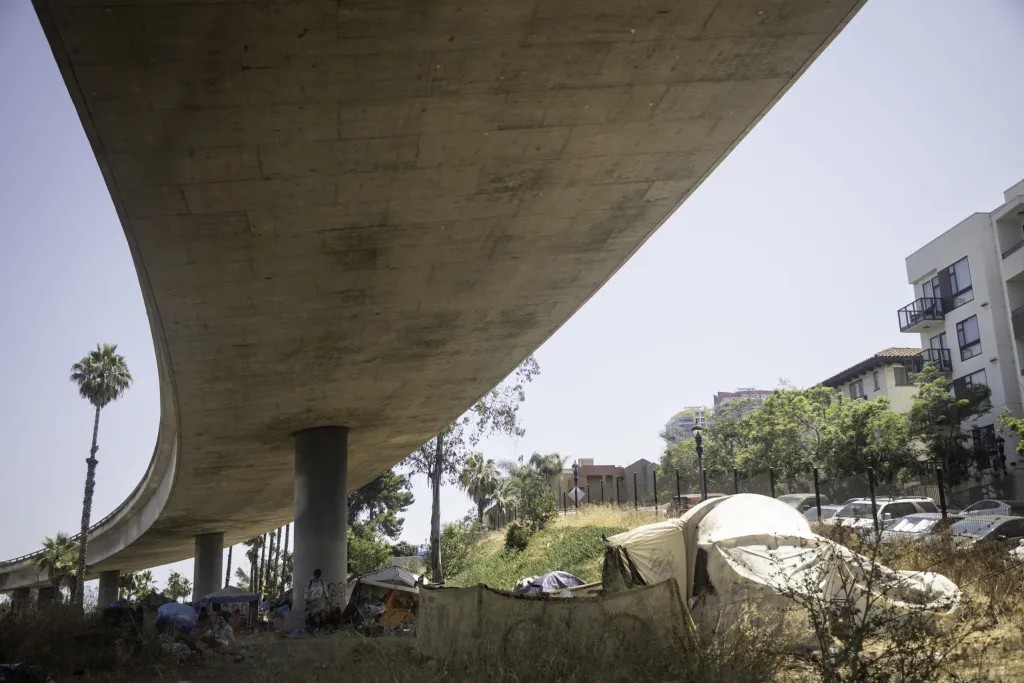This article first appeared in inewsource. Sign up for their newsletters here.
Expected Trump administration funding cuts could slash millions from programs that give formerly homeless San Diegans permanent housing.
The Department of Housing and Urban Development is planning to reduce the amount of funding for permanent housing by two-thirds in its Continuum of Care Program, according to a report by Politico based on internal HUD documents. The program’s goal is to permanently end homelessness by giving people a permanent home.
HUD will instead focus on transitional housing with work requirements nationwide. The pool of funding for permanent housing will drop from $3.3 billion to $1.1 billion nationally, Politico reported.
In San Diego, the cuts could impact about $40 million the program is expected to bring in through 2026: $30 million of that pays for the permanent housing units themselves, $17.5 million pays for supportive services; and $13 million pays for rapid rehousing, which provides rental assistance for up to two years along with supportive services with the goal of transitioning people to long term stable housing.
Under the cuts, the Regional Task Force on Homelessness would need to wind down the rapid rehousing program, letting people finish out their leases without taking on new clients, as well as cut into supportive services and operating costs, Regional Task Force on Homelessness CEO Tamera Kohler said.
“I’m not going to break any leases to the best of our ability. We’re not going to displace anybody to the best of our ability,” she said, adding that the rapid housing units would be lost after people already in the program finished their leases. The program has proved to help people stay housed, she said.
“What was found over years of practice is that rapid rehousing works better to end someone’s homelessness because it gets them back out into the community with their own lease.”
Since last year, the number of unhoused people has dropped 7% in San Diego County and 13.5% in the city of San Diego, according to the annual point-in-time count of unhoused people. The decreases break a four-year upward trend. Advocates for unhoused people worry that the encouraging downward trend could quickly reverse course if HUD follows through with the cuts.
“These are individuals that need this support. If this support is pulled out from under them, they’re going to wind up falling back onto the streets,” said Deacon Jim Vargas, president and CEO of Father Joe’s Villages, adding that the cuts would also harm support programming that helps keep people from falling back into homelessness. Most people in permanent housing and all who receive permanent housing supportive services struggle with a disability, mental health or substance abuse and have been previously chronically unhoused.
Father Joe’s has 540 clients who have received housing through the $4 million the nonprofit gets from HUD. The change in HUD’s philosophy won’t affect only those currently in the program. Vargas said future projects would not have permanent housing options because the government wasn’t giving out additional vouchers.
“This is quite something that’s brewing. It’s a big deal to the community of San Diego,” he said.
The San Diego Housing Commission, the top recipient of funds for the program, is set to receive $11.7 million for 2026 to provide housing and assistance to 481 households. A “dramatic reduction” in federal funds would “likely result in a return to homelessness for many of them,” agency spokesperson Scott Marshall said.
Shift to transitional housing
The move to focus on transitional housing aligns with previous statements from HUD officials.
“Our ultimate goal is to reduce reliance on government assistance,” HUD Secretary Scott Turner wrote in the 2026 performance plan, a document HUD releases to plan for the upcoming year.
Kohler said if HUD moves Continuum of Care funding for permanent housing to transitional housing, the change would immediately increase the number of people considered homeless in the region.
Advocates said transitional housing plays an important role in fighting homelessness, but it isn’t sufficient on its own.
“Transitional housing is a shelter type of situation. It’s not permanent housing. It has the word housing in it, but it’s not housing,” Vargas said. “That’s all a stopgap. None of that is permanent affordable housing and permanent supportive housing. That is what breaks the cycle of homelessness.”
Father Joe’s started funding transitional housing through philanthropy on its own 10 years ago when the government moved away from funding it. But philanthropy won’t be able to make up the federal losses on funding for permanent housing, Vargas said.
Over time, they have found that a one-size-fits-all approach to homelessness doesn’t work.
“It’s not a matter of saying that everything should be permanent housing, and it’s not a matter of going to the other end of the spectrum,” he said. “We understand what people’s unique needs are and then provide the resources that are necessary.”
inewsource is a community-focused nonprofit, nonpartisan newsroom dedicated to investigative and accountability journalism. The news outlet is a 2025 Pulitzer Prize finalist.
READ NEXT

